Ijraset Journal For Research in Applied Science and Engineering Technology
- Home / Ijraset
- On This Page
- Abstract
- Introduction
- Conclusion
- References
- Copyright
Smart Agriculture Suggestion System
Authors: Vipul Kashyap, Dhruv Darji, Yash Mistry, Prof. Chhaya Dhavale
DOI Link: https://doi.org/10.22214/ijraset.2022.41717
Certificate: View Certificate
Abstract
Agriculture is a career that has been performed for many years. However, as time passes, people\'s confidence in this profession is eroding. One of the reasons for this is that agriculture is practiced in an unscientific manner. Traditional approaches are getting less successful as time passes. To address this, the method described here analyses the current environmental and soil parameters and predicts the best crop for the scenario. This technology is intended to assist farmers by serving as a gateway between them and all accessible information. The project\'s main goal is to gather information from many sources on the internet and display it to the user in a user-friendly and understandable manner. This site will serve as a resource for farmers around the country, as 3well as a platform for them to connect and share their important resources and expertise with one another. We also want to dedicate a part of this programme solely to crop, equipment, and labour management. We want to make resource collection and farm management considerably more efficient.
Introduction
I. INTRODUCTION
Agriculture, farming, and husbandry have all been important occupations throughout human history. Agriculture refers to all organisms that are part of the human food chain in a linear order. Humans are the most intelligent living species on the planet.
As a result of their intelligence, they are constantly compelled to alter and create. This is thought-provoking.has resulted in the development of the wheel, improvements in living conditions and fashions, languages, and life itself. expenditure methodologies, and a slew of other accomplishments Major inventions have resulted from mankind's restless attitude toward innovation. which have not only made life easier for humans, but have also increased efficiency. This resulted in higher production at the expense of fewer talents. The improvements in Agriculture are required to balance demand and supply as the world's population grows. Throughout the day The need for food has increased dramatically in the last fifty years and earlier. To transcend the constraints, and the use of contemporary technologies to this critical source of energy It is terrible to be a human. The efficiency of the system may be increased by utilizing current and sophisticated technology. The agricultural industry may be enhanced, not only in terms of production, but also in terms of quality.In addition, compared to traditional approaches, it reduces intra-field and inter-field losses.
Agriculture has always been an important element of human civilization due to the fact that man cannot live without it.Agriculture and the environment are inextricably linked. This fact contributes to progress. and the improvement of the commonly utilized, ineffective, and time-consuming techniques for agricultural purposes The fast-paced world, new trends, and technology advancements have all had an impact.
People's lifestyles were altered. Emerging new technologies are playing an increasingly essential role. Out of the norm Smart homes and grids, smart cities , smart campuses, and smart farming are all examples of smart technologies. some of the most modern and updated communication and information technologies that assist people in saving time and obtaining more accurate results.
II. LITERATURE SURVEY
Paper-1: IoT Based Farming Recommendation System Using Soil Nutrient and Environmental Condition Detection
Publication Year: 2019
Author(s):Arun Kumar, Abhishek Kumar, Akash De, Shashank Shekhar, Rohan Kumar Singh
Summary: This paper demonstrates how an IoT (Internet of Things)-based model can be used to optimise soil productivity. The paper, in particular, describes how to determine the amount of Following that, the soil nutrients and environmental conditions will be discussed. Cropping recommendations and site-specific fertilisation Nitrogen, phosphorus and potassium are the key nutrients that are in charge of the plant's growth Soil moisture and pH level and environmental conditions have an impact on productivity crops. In the current work, the system is integrated with various NPK, pH, and soil moisture levels are reported using chemicals and sensors. forecast for level, temperature, and weather The system under consideration takes a soil sample as input and runs the chemical As a result of the reactions, corresponding changes in the colour of the sample are detected.
Paper-2:. Agriculture System Using Android Device
Publication Year: 2020
Author(s):Ganesh S. Wedpathak
Summary: Using the concept of Horticulture and Android, this research paper introduces a "Farmer Helping Service" system that will provide farmers with detailed information on fruits, vegetables, and flowers. This system can provide information using an Android smart phone from anywhere and at any time, without the need for an internet connection, and at no cost.
Paper-3: Survey of Android Apps For Agriculture Sector
Publication Year: 2020
Author(s):Dharmendra Patel ,Hetal Patel
Summary: This paper investigates how Android Apps for agricultural services have influenced farmers' farming activities.Mobile-enabled information services and the rapid growth of mobile telephony are improving information dissemination in the knowledge-intensive agriculture sector. It bridges the gap between agricultural input availability and agricultural output delivery, as well as agricultural infrastructure.Immersion techniques include mobile computing, cloud computing, machine learning, and soft computing being used in nearly all fields of study.
Paper-4: Digitalisation of agricultural knowledge and advice networks: A state-of-the-art review
Publication Year: 2020
Author(s): Simon Fielke, Bruce Taylor, Emma Jakku
Summary: In this paper, we examine trends in agricultural knowledge and advice networks both globally and in Australia in order to anticipate and prepare for potential changes in these networks.
We reach three key conclusions about the state-of-the-art through a combined structured and traditional review of relevant literature. First, the connectivity of humans and technologies in agricultural knowledge and advice networks and value chains is expected to grow further. Second, growing connectivity will drive and be driven by increased transparency of agricultural practises and informational interaction between farmers, advisors, agri-businesses, consumers, and regulators. Finally, as agricultural innovation systems digitalize, it is likely that there will be difficulties in balancing the priorities of various agricultural stakeholders. These findings have implications for international agrifood sector oversight.
III. PROPOSED SYSTEM
In general, we consider a machine/artifact or any system to be smart if it does a task that we believe an intelligent human could perform. Any system, process, or domain is considered to be intelligent if it adheres to the six degrees of intelligence.
- Adapting: The term adapting refers to a modification made to satisfy a specific need. In the context of smart agriculture, these changes are referred to as environmental adjustments.
- Sensing: The ability to detect or monitor changes in one's environment.
- Inferring: This is a term that refers to drawing a conclusion based on data and observations.
- Learning: After you've gotten your findings and seen the outcomes, you may utilize what you've learned to enhance the techniques you've been using. It entails several types of information.
- Anticipating: This refers to imagining something fresh and inventive that will occur, or we may refer to it as the next level of anything.
- Self-Organizing: This term refers to any intelligent system that has the potential to self-organize.
A. Data Flow Diagram
DFD is the abbreviation for Data Flow Diagram. The flow of data of a system or a process is represented by DFD. It also gives insight into the inputs and outputs of each entity and the process itself. DFD does not have control flow and no loops or decision rules are present. Specific operations depending on the type of data can be explained by a flowchart. Data Flow Diagram can be represented in several ways. The DFD belongs to structured-analysis modeling tools. Data Flow diagrams are very popular because they help us to visualize the major steps and data involved in software-system processes
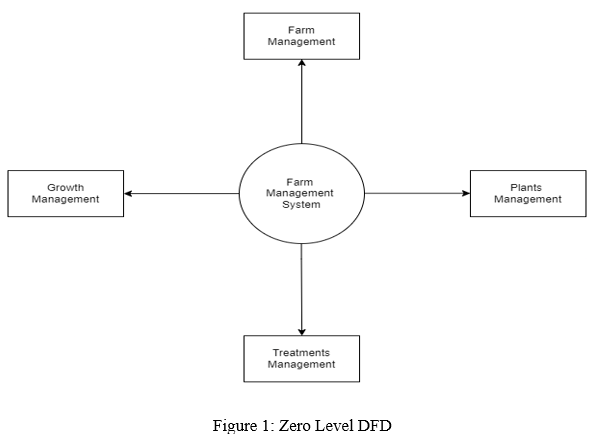
B. Zero Level DFD
It is also known as a context diagram. It’s designed to be an abstraction view, showing the system as a single process with its relationship to external entities. It represents the entire system as a single bubble with input and output data indicated by incoming/outgoing arrows.
This is the 0-level of the Farm management system, where we have elaborated the high-level processes of the farm. It’s designed to be an at-a glance view of Growth, user, login showing the system as a single high-level process, with it’s relationship to external entities of farm, treatments, plants.
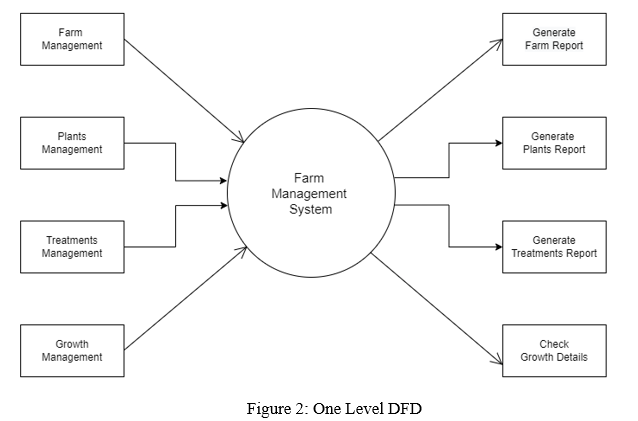
C. One Level DFD
In 1-level DFD, the context diagram is decomposed into multiple bubbles/processes. In this level, we highlight the main functions of the system and breakdown the high-level process of 0-level DFD into sub processes.?
1-level DFD of Farm management system shows how the system is divided into sub-systems, each of which deals with one or more of the data flow to or from an external agent, and which together provide all the functionality of the farm management system as a whole.
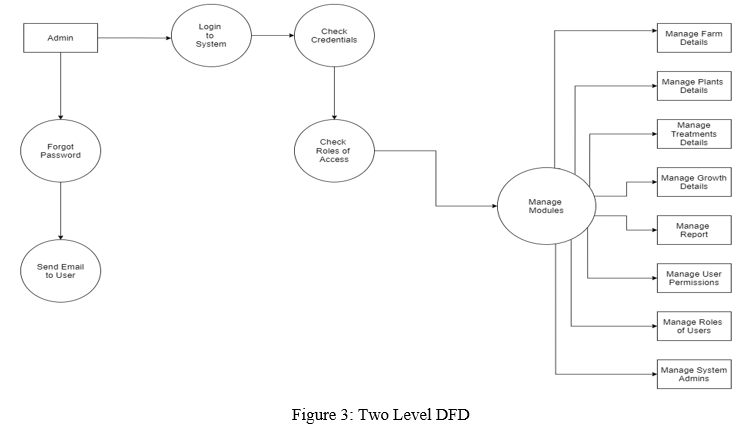
D. Two Level DFD
2-level DFD goes one step deeper into parts of 1-level DFD. It can be used to plan or record the specific/necessary detail about the system’s functioning.?
It may require more functionalities of farm to reach the necessary level of detail about the farm functioning. The 2-level DFD contains more details of the login, users, farm, treatment, medicines.
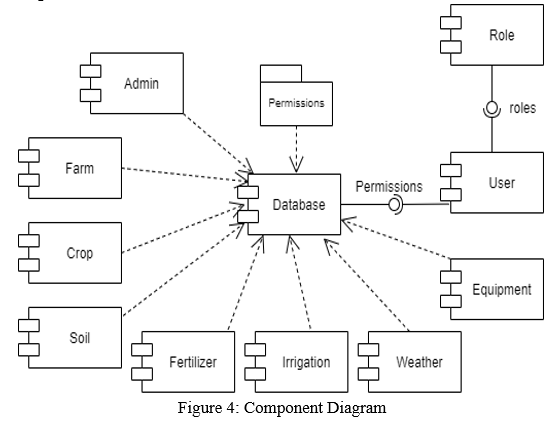
E. Component Diagram
A component diagram, also known as a UML component diagram, describes the organization and wiring of the physical components in a system. Component diagrams are often drawn to help model implementation details and double-check that every aspect of the system's required functions is covered by planned development. In the first version of UML, components included in these diagrams were physical: documents, database table, files, and executables, all physical elements with a location. In the world of UML 2, these components are less physical and more conceptual stand-alone design elements such as a business process that provides or requires interfaces to interact with other constructs in the system. The physical elements described in UML 1, like files and documents, are now referred to as artifacts. A UML 2 component may contain multiple physical artifacts if they naturally belong together.
IV. RESULT
Here the results are given in the form of screenshot of the modules done in our website. There are many modules in our website such as weather forecasting, labour ad posting and crop calender
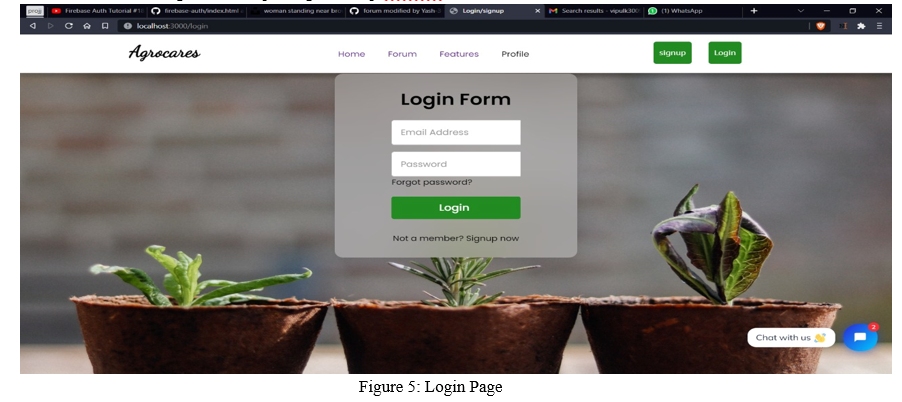
This is the Login Page of our website, where admin will be able to login in their account using their credentials. We are gonna assign roles to every member such as agricultural expert, labour, admin and their login access will decide how after login user can manage all the operations on Farm, Employees, Growth, Plants, Treatments. All the pages such as Growth, Plants, Treatments are secure and user can access these page after login.
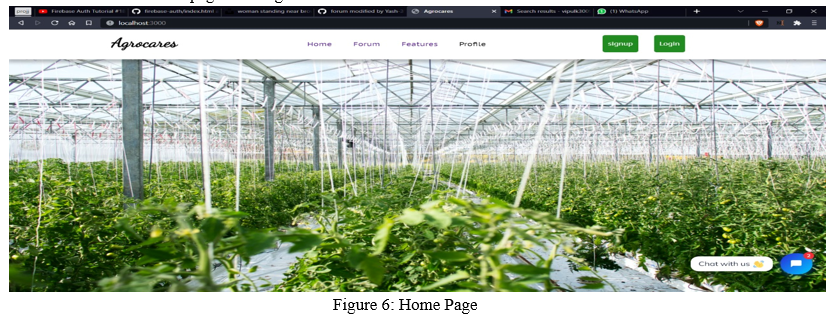
Above is the homepage of our website from where farmers can click on the feature they want to select the UI of our website is very simple and easy to understand so that the farmers can use it easily we also have a chatbot in our Home Page so it will have pre inserted commands which will be helpful to the farmers and if the problem is not solve by the the bot then we will forward the problem to the expert. Once login process is done, the user lands on the home page of the website, from where they can perform different activities like check for notice, register/view complaint, update his profile, see the list of upcoming events etc. Once, work is completed then they can logout of the system using logout button.
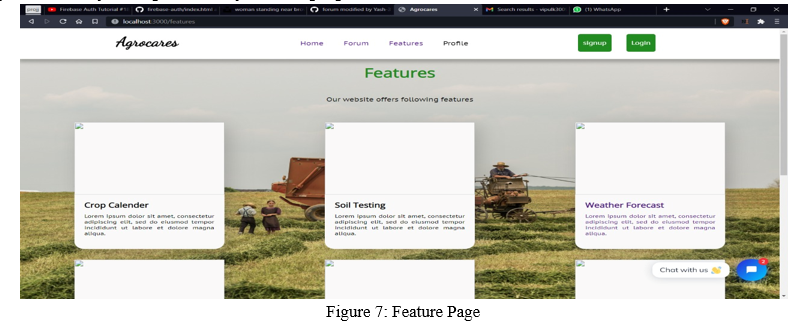
Above is the page where all the features will be listed from where the farmers or expert according to the roles assign to them can go to modules the modules like Mandi price , Soil Testing, Weather Forecast and Talk to an Expert
Soil Testing: sensors. The system rely on color charts to match the nutrient levels in a soil solution. The kit provides basic guide of the pH and nutrients that are immediately available and they are best for farmers from diverse demographic dimensions.
Farmers Guide : Basic guide on how to plant manage water certain plants (basic details on common crops)
Weather Forecasting: Weather forecasting mainly for droughts , frost, sudden showers or dry spells.
Crop Calendar : Crop calendar is a module used for tracking the crop growth. You enter the planting date and crop it will tell the date of harvest. To get a rough estimate and help in pre booking of labours etc.
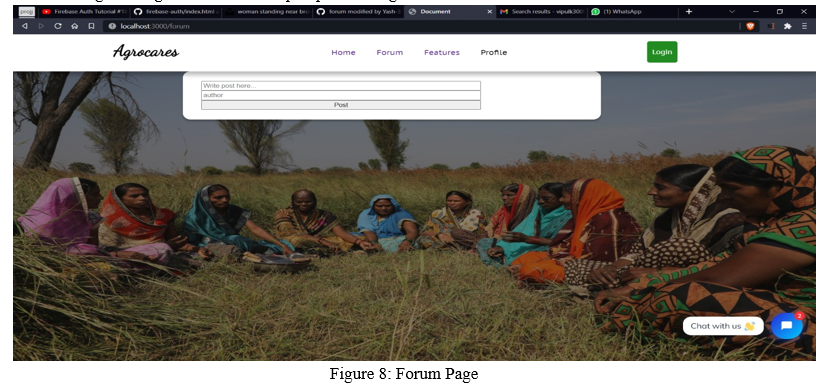
This is the Forum page where the author or in the case farmers and this will act as a platform for farmers across the country to connect and share their valuable resources and knowledge with their fellow farmers. This Module is designed to aid farmers by acting as portal between them and all the information available.
Conclusion
The conclusion drawn from the system is that how Android Apps for agricultural services have influenced farmers\' farming activities .Mobile-enabled information services and the rapid growth of mobile telephony are improving information dissemination in the knowledge-intensive agriculture sector. It bridges the gap between agricultural input availability and agricultural output delivery, as well as agricultural infrastructure. Agrocare is an invaluable source of information on the current state of Indian agriculture as well as the sole source of some important information on the linkages between fields, farms, and families that serves to illuminate the challenges faced by agriculture policy makers and farm families. Apart from technical advancements paving the way for smart agriculture, there are several concerns linked to agricultural progress that must be addressed in order to benefit this business with which humans are directly associated so our system is able to reduce the bridge of gap between the farmers and technology and help them with the resources they need
References
[1] https://www.ijstr.org/final-print/may2018/Housing-agriculture-Management.pdf [2] http://www.ijst.co.in/papers/vol6issue2/ijst160402 [3] https://www.ijera.com/papers/Vol4issue2/Version [4] -• IoT Based Farming Recommendation System Using Soil Nutrient and Environmental Condition Detection-Arun Kumar, Abhishek Kumar, Akash De, Shashank Shekhar, Rohan Kumar Singh [5] - • Digitalisation of agricultural knowledge and advice networks: A state-ofthe- art review-Simon Fielke?, Bruce Taylor, Emma Jakku [6] -• Agriculture System Using Android Device - A Review Paper-Ganesh S. Wedpathak [7] • SURVEY OF ANDROID APPS FOR AGRICULTURE SECTOR-Hetal Patel and Dharmendra Patel [8] -https://www.nature.com/scitable/knowledge/library/soil-the-foundation-of-agriculture-84224268/ “ [9] -https://www.yourarticlelibrary.com/soil/soils-of-india-six-different-types-of-soils-found-in-india/12779 [10] -https://www.sciencedirect.com/referencework/9780123485304/encyclopedia-of-soils-in-the-environment https://meteologix.com/in/weather/10742780-soil [11] -Organic farming and the sustainability of agricultural systems D. Rigby a,*, D. CaÂceres b [12] -The crop yield gap between organic and conventional agriculture Tomek de Ponti, Bert Rijk, Martin K. van Ittersum ? [13] -Decision support tools for agriculture: Towards effective design and delivery David C. Rose a, ?, William J. Sutherland a , Caroline Parker b , Matt Lobley c, Michael Winter c, Carol Morris d, Susan Twining e, Charles Ffoulkes e, Tatsuya Amano a, Lynn V. Dicks a,f
Copyright
Copyright © 2022 Vipul Kashyap, Dhruv Darji, Yash Mistry, Prof. Chhaya Dhavale. This is an open access article distributed under the Creative Commons Attribution License, which permits unrestricted use, distribution, and reproduction in any medium, provided the original work is properly cited.

Download Paper
Paper Id : IJRASET41717
Publish Date : 2022-04-22
ISSN : 2321-9653
Publisher Name : IJRASET
DOI Link : Click Here
 Submit Paper Online
Submit Paper Online

